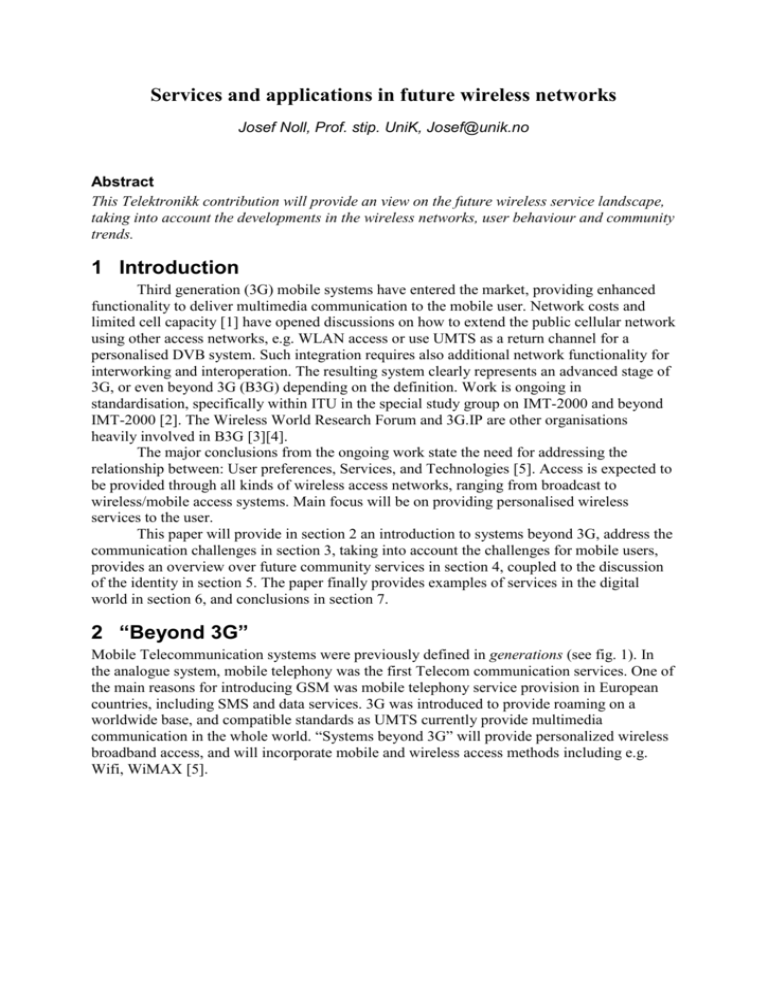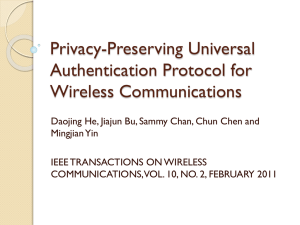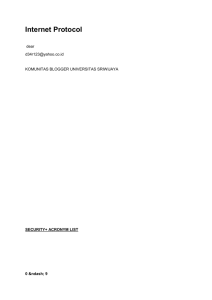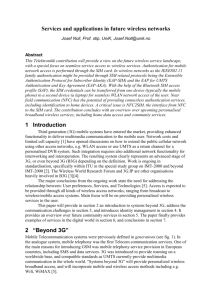200608Telektronikk
advertisement

Services and applications in future wireless networks Josef Noll, Prof. stip. UniK, Josef@unik.no Abstract This Telektronikk contribution will provide an view on the future wireless service landscape, taking into account the developments in the wireless networks, user behaviour and community trends. 1 Introduction Third generation (3G) mobile systems have entered the market, providing enhanced functionality to deliver multimedia communication to the mobile user. Network costs and limited cell capacity [1] have opened discussions on how to extend the public cellular network using other access networks, e.g. WLAN access or use UMTS as a return channel for a personalised DVB system. Such integration requires also additional network functionality for interworking and interoperation. The resulting system clearly represents an advanced stage of 3G, or even beyond 3G (B3G) depending on the definition. Work is ongoing in standardisation, specifically within ITU in the special study group on IMT-2000 and beyond IMT-2000 [2]. The Wireless World Research Forum and 3G.IP are other organisations heavily involved in B3G [3][4]. The major conclusions from the ongoing work state the need for addressing the relationship between: User preferences, Services, and Technologies [5]. Access is expected to be provided through all kinds of wireless access networks, ranging from broadcast to wireless/mobile access systems. Main focus will be on providing personalised wireless services to the user. This paper will provide in section 2 an introduction to systems beyond 3G, address the communication challenges in section 3, taking into account the challenges for mobile users, provides an overview over future community services in section 4, coupled to the discussion of the identity in section 5. The paper finally provides examples of services in the digital world in section 6, and conclusions in section 7. 2 “Beyond 3G” Mobile Telecommunication systems were previously defined in generations (see fig. 1). In the analogue system, mobile telephony was the first Telecom communication services. One of the main reasons for introducing GSM was mobile telephony service provision in European countries, including SMS and data services. 3G was introduced to provide roaming on a worldwide base, and compatible standards as UMTS currently provide multimedia communication in the whole world. “Systems beyond 3G” will provide personalized wireless broadband access, and will incorporate mobile and wireless access methods including e.g. Wifi, WiMAX [5]. Figure 1 - Service evolution from mobile telephony to personalized broadband wireless services Standardization of the system B3G has started in 2000, and consists of the three major elements: Wireless services: Users prefer to receive their services wireless, either through the mobile network or a wireless (Wifi) connection. This statement is underlined by the sales numbers of mobile phones and laptops: There are 1.5 billion cell phones in the world today, more than three times the number of PCs [6]. In June 2005 the number of laptops sold bypassed the number of fixed PCs [7]. Broadband services: Market expectations for fixed broadband services estimate that 60 % of household will have broadband in 2007 [8]. Mobile broadband services like TV and video telephony are available in most 3G markets. Personalised Services: The wide distribution of mobile phones has increased the need for adapting the content to both user preferences and terminal capabilities. 2.1 Wireless Services The major challenge of wireless service provision is the variation in radio quality. Radio is a shared resource, and the quality of the radio link is affected by: User mobility Radio environment (user speed and coverage radius) Application topology User terminal requirements Service delivery to a wireless terminal should take into account the Quality of Service (QoS) measures on the radio interface, e.g. Propagation delay, variation of delay, bit error rate, error free seconds, distortion, signal to noise ratio, duration of interruption, interruption probability, time between interruption, bit rate, and throughput. These parameters will depend on the user and terminal environment, and underline that an optimum access will have to use all available wireless and mobile connections. 2.2 Broadband Services Gordon Moore’s prediction, popularly known as Moore's Law, states that the number of transistors on a chip doubles about every two years (see fig. 2) [9]. Since the digital era has started, the amount of information created three-doubles every 12 months. Comparing these growth rates with the increase of modem speed and air interface capacity, shows that modem speed has a similar growth rate as number of transistors, while air interface capacity has not increased substantially from GSM to 3G/Wifi. The experienced increase in air capacity is due to increase bandwidth of the communication channel, from BGSM = 200 kHz in GSM to BUMTS = 3.8 MHz in UMTS, and B802.11 = 25 MHz for 802.11b. tio nc 1,00E+05 t sis ati o Inf orm 1,00E+04 1,00E+02 1,00E+07 rea 1,00E+06 1,00E+03 Number of transistors n Transmission rate r be of 1,00E+06 n tra ed m Nu 1,00E+00 1,00E+05 pe ms de Mo 1,00E+01 1,00E+04 ty Air interface capaci 1,00E-01 1970 ors 1975 1980 1985 1990 1995 1,00E+03 2000 Year Figure 2 - Moore's law in transmission capacity and information creation Claude E. Shannon defined the capacity C of a system as being proportional to the bandwidth B (see eq 1). C = B log2 (1 + P/N0B), (1) with C being the capacity of the system, B the bandwidth of the carrier, P the signal power and N0 the noise level of the system. For a given bandwidth B, the maximum range Rmax is a log-function of the signal to noise ratio (eq 2). Rmax = log2 (1 + P/N0) (2) Propagation attenuation (free space loss) is proportional to the carrier frequency, thus carriers such as Wifi have shorter ranges as GSM, but provide higher throughput. These indications support the usage of specific access networks for applications, e.g. broadcast for video, Wifi for email and ftp services, and GSM/UMTS for mobile services. It can be assumed that services are available in all access technologies, but will have their preferred network for operations. 2.3 Personalised Services In order to design and develop innovative and successful services one has to understand the user and be able to “guess” his needs. This is the area of market researchers and service designers who have to sense and test the usability and social impacts of new service concepts, while looking for the added value that could make a service offer a success. To that end a phased methodology is recommended addressing the following topics [5]: 1. Understanding the users by understanding their culture and lifestyle 2. Creating potential service concepts that satisfy particular user needs described by technical details and likely usage 3. Validating the service concept against potential users by means of prototypes and models To build these types of personalised services is a challenge to the system design as well as the user interface. The system should be flexible and allow the definition of personal preferences, and these should be carried seamlessly with the user as he moves geographically or between access networks. The user interface should be such that personalisation is easy and intuitive. Personalisation might be supported by “learning” profiles, handling the preferences of the user, the “presence” (where is the user, what is he doing), and the social/community characteristic of a user. The next section will provide an overview over existing developments, in order to overcome the limits between wireless and mobile networks. 3 Communication challenges This section addresses the communication challenges of a mobile user, analysing trends in radio communication development, the position of the mobile phone and authentication as key issue for user acceptance. 3.1 Radio communications Section 2 has concluded that optimum access networks will have to be used for the specific applications. This section will look into existing standardisation and market trends, e.g. UMA, IMS, and Bluephone. 3.1.1 Unlicensed Mobile Access (UMA) The UMA Technology specification will allow the usage of mobile phone in unlicensed bands, typically using Wifi or Bluetooth as radio interface. Typical applications cover the home and office environment, where WLAN subnets exist, but usage of mobile phones in those networks is not supported. Submitted in February 2005 to the 3rd generation partnership project (3GPP), UMA specifications are adopted as Generic Access Network (GAN) within the GERAN (GSM/EDGE Radio Access Network) TSG (Technical Specifications Group). UMA) has thus become the standard for fixed-mobile convergence (FMC). UMA technology enables access to mobile voice, data and IMS services over IP broadband access and unlicensed spectrum technologies. By deploying UMA technology, service providers can enable subscribers to roam and handover between cellular networks and public and private unlicensed wireless networks using dual-mode mobile handsets. With UMA, subscribers receive a consistent user experience for their mobile voice, data and IMS services as they transition between networks [10]. 3.1.2 British Telecom – Bluephone/Fusion While Eurescom launched a study called “Public Bluetooth Access” in 2001 [11], parallel developments started at British Telecom (BT) to enable Bluetooth based mobile services. Technical problems as interference, especially in the voice channel, and missing standardisation delayed the launch of the Bluephone product until mid June 2005 [12]. After successful customer testing in 2005, BT runs the service as a conventional FMC package called Fusion, offering a WiFi/Bluetooth combined router, which they can plug into BT Broadband ADSL at home. Currently two mobile phones are supported, Motorola’s RAZR V3 and V560, allowing up to 3 simultaneous phone calls over the landline. The main difference between Fusion and UMA is the focus of the network operator. Fusion is based on SIP and IMS standards, thus promoting the developments in the direction of next generation networks, while UMA brings the home area into the mobile network, using mobile network core technologies. 3.2 My future terminal While the access network development will follow the main position of the operator, i.e. mobile operators will tend to promote UMA, while fixed network operators will promote Fusion-like approaches, the developments on the terminal side are more widespread. We see two major trends, on one side following the PC and making applications available for the mobile user, and on the other side the development of specific mobile services, promoting lifestyle and community services. The mobile phone has the major advantage, as it is available 24 h/7 days a week, as compared to about 4 h average usage of a PC. Thus, the mobile phone provides the always online functionality with availability, email and Internet access (see fig. 3). While this trend is visible in the enterprise market, the consumer market is dominated by lifestyle trends. Decisions to buy a certain phone are rather based on attitude, e.g. the tough phone for the outdoor person, and the city phone for the urban person. What is common in both trends is that the service availability has reached all phones. Communication and interaction is provided, connectivity to my community (fig. 3, left), local services as public transport information (fig. 3, middle) and video/TV (fig. 3, right) show some of the potential services. Figure 3 - Functionality of mobile terminals, e.g. communication portal (left), public transport information (middle, from [13]), video/surveillance (right) The mobile phone has several service enablers inbuilt, i.e. positioning information, potential for seamless and personalised service access, mobile commerce, and adaptation of content to personal preferences. However, these advantages are not properly addressed by the operators yet. The following section will provide examples of personalised service access, indicating the potential of mobile services, but also addressing the current deficits. 3.3 Device, Network and Service Authentication Authentication is the key for a customer relation, and the entry for value-added services. Telecom customers are used to hassle-free access (GSM works everywhere), and will expect the same functionality for access to other networks and services. The customer is used to having her mobile phone around, and the SIM card opens for authentication and encryption in every wireless network (Bluetooth, WLAN, WiMAX) in addition to GSM and UMTS. Service authentication has to satisfy the security requirements of the application, e.g. nice to know security for network access, need to know security for email and intranet access and have to know security for VPN and mCommerce services. We suggest following the mechanisms suggested by the Initiative for open authentication (OATH1): • SIM authentication (SIM) • Public Key Infrastructure (PKI) • One-Time-Password (OTP) These mechanisms fulfil the requirements of the Norwegian Government and other European countries for an eSignature. The mobile phone has the capabilities of providing all of them: SIM, PKI and OTP, and thus may provide the security requirements for various applications Seamless authentication Authentication provider Service access Physical access VPN Home access, .mp3, .jpg in the virtual world. Figure 4 - The mobile phone as authentication device for admittance, network and service access The security requirements might be satisfied through SIM authentication, and can be enhanced through a password/pin mechanism. Highest security requirements are required for have to know services, such as admin access to home content or electronic transactions. We recommend a PKI based authentication, which most European Operators have on their SIM cards [14]. SIM authentication is used for GSM/UMTS network access and also as transaction receipts for content download, e.g. ring tones. Including authentication methods through Bluetooth and Near Field Communications (NFC), SIM-based authentication opens for all types of service access, providing admittance (keys, access cards, and tickets), payment (wallet) and content access (home). Examples of such services are presented in fig. 4, indicating mobile service access for banking, or ticket ordering, physical access based on proximity card functionality, VPN access based on have to know authentication, and need to know access to private home content. 4 Community Services Having addressed security requirements and mobile phone/SIM-based authentication as a major service enabler, this section will address upcoming services. It will first address 1 http://www. www.openauthentication.org/ community services, and then position the mobile phone as integrator for mobile and broadband services. 4.1 Communities, groups and roles The trend to digital services has reached the every-day life. Information is spread by Internet, email and SMS, rather than by plain paper. Youngsters use micro co-ordination, using the mobile phone to communicate at every minute with their community [15]. Depending on the context, these communities are changing, ranging from working colleagues to friends, to members of classes, school, or sporting clubs. Figure 5 indicates a location based service for a friend community, indicating at every time where your friends are, and even introducing an alert when a friend comes nearby. The mobile phone is the preferred device to keep control of your communities, providing availability, location and communication. Figure 5 - Community service, location of friends Community services will become more dominant in the future, addressing contact, location and availability as well as exchange of pictures, music and other digital content. 4.2 Digital content: Picture, Video, Music The digital home has turned into reality. As predicted by the Eurescom study P1401, market developments and social trends show that flat screen and high-definition TV (HD-TV), broadband recording either on DVD or on hard-disk recorders, and the transformation from analogue to digital video and photography are the dominant events in 2006 [16]. The home broadband connection (e.g. ADSL) supports always online and enables on-demand services. Residential gateways are getting more mature, cheap, and offer innovative services in addition to communication. The social drives of a broadband, always-on connection are on-demand video, and multimedia social connectivity. The home portal becomes the centre for communication, making people’s content available in and outside the home and allowing for the control of the home infrastructure. Even though video and TV recording are the current drivers, photo and music exchange are the mature market services. Current upload/download network access rates support file exchanges (typical 1-3 MB) and audio streaming (typical 128 kbit/s), while video exchange is still cumbersome. More advanced personal data recorders will support the streaming of video content in a mobile format, providing reasonable mobile video quality at data rates up to 384 kbit/s. P1401 suggests to subdivide broadband home services into four categories; Entertainment, Home automation, Personal Enrichment and Social Inclusion [16]. This paper will concentrate on entertainment, providing electronic content like music, video and data while being on the move. 4.3 Mobile and Broadband – a Synergy Chapter 3 has provided evidence for the fixed mobile integration, based on IMS or SIP standards. This paper goes beyond network access, and suggests the mobile phone to become the identifier for home broadband services (see fig. 6). It’s me, get my services (seamless authentication) Remote control Extra channels Extra information, IP services: http://JamesBond.com My personal EPG Figure 6 - Using the mobile to control and receive broadband services [] Digital divide is the keyword indicating who is able to support 5 My Identity in the Digital World 5.1 Biometrics versus SIM card Security requirements (banking) 5.2 Supporting technologies NFC NFC communication unit NFC reader NFC2SIM SIM Smartcard interfaces ISO/IEC 7816 Figure 7 - Mobile authentication based on near field communications (NFC) 6 Entering the Digital World 6.1 Examples Figure 8 - Seamless authentication, used for bank access (left) and community address book (right) 6.2 Challenges/Ongoing Research DRM example/ 1. Request for home content 4. Request DRM key for selected content NFC communication unit NFC2SIM Internet Internet 3. Streaming of encrypted content NFC 5. Return DRM key 2. Seamless authentication and redirect to personalised content SIM with DRM keys Home access, .mpg, .mp3, .jpg Figure 9 - Digital Rights Management (DRM) based on DRM keys stored on the SIM card of the mobile phone 7 Summary REFERENCES:







